
23 Web Scraping Project Ideas Without Coding for 2025
It seems easy to come up with project ideas until you’re looking at a blank screen and unsure of where to start.

And when it comes to web scraping, it’s so easy to feel stuck, questioning, “What project should I even build?” or “Is there anything new left to create?”
But here’s the thing: there’s always a gap waiting to be filled by your innovative project!
- A need that hasn’t been fully met.
- A data set waiting to be unlocked.
- A market is craving faster, smarter solutions.
And on top of that, who complains when given an easy web scraping tool to work with? Nobody! We all want that smoothness. We all want convenience, even while web scraping.
That’s why our focus on this blog will be exploring a few necessary web scraping project ideas that you can start on. The best part is that these projects don’t just fill existing market gaps (and are in demand), but you can also capitalize on and generate some income from them.
Because yes, projects can be stressful. But once you have the right idea, nothing can stop you from thinking bigger, building smarter, and creating something that truly stands out.
Let’s get into it.
Why Go For No-Code Web Scraping Projects?
Time-to-market is everything in web scraping, especially when just starting out!

It can take weeks or even months to build a scraper from scratch with code. Just picture it; you’re debugging, testing, and endlessly tweaking your code, so it will obviously take some time.
However, if you opt for the no-code approach, you completely bypass the struggles of coding, allowing you to start collecting and working on your project immediately.
With No-code web scraping projects, you can:
- Work super fast
- Focus on what to scrape, not how to code it
- Free yourself from the hassle of technical maintenance
- Spend less time pivoting and testing, especially if something fails to work out
All these pros make the no-code approach something to go for.
But here’s a question: Where do you get the project ideas? When does it just click that Yes, I can make something meaningful here?
I mean:
How Do You Spot A Gap for Your Next Web Scraping Project?
Finding the right project is the most crucial part of the game, but there’s a trickier part: you don’t just need data; you need data that solves a problem.
And to do that, you must be keen enough to spot gaps. These are the places with inefficiencies, outdated data sources, or markets in dire need of smarter solutions.
To make it easier for you, here’s how to find those gaps and then turn them into profitable web scraping projects:
1. Look for Inefficiencies
First, ask yourself: Where are people spending too much time on repetitive tasks that could be automated with data scraping?
We know that efficiency is the key to any valuable project, and that scraping is all about making tasks easier and faster.
So, think about it:
- Manual research: People out here are still spending hours digging through job boards, e-commerce sites, or real estate listings. What if you could scrape that data and deliver it in a neatly organized format, ready for analysis and interpretation?
- Data collection for market research: Businesses need fresh market insights to stay competitive. Imagine having product pricing, customer reviews, or competitor analysis data from thousands of online stores and making it readily available! Sounds good, right?
When you notice a repetitive task taking forever, web scraping can be the solution!
2. Find Outdated Data Sources You Can Refresh
You can opt to look for outdated or incomplete data sources. Unfortunately, many businesses are still working with outdated data today, which presents significant innovation opportunities.
Here are some examples:
- Job listings: Many companies still rely on outdated data from old job boards or career sites.

If those listings aren’t being refreshed regularly, you can use a scraper that pulls new listings from a wider set of sources, offering more up-to-date data.
- Real estate listings: The property market is fast-paced. Scraping real-time data from poorly updated listings on traditional sites can fill a considerable gap.
- Event data: Festivals, conferences, and trade shows often have infrequent updates. You can keep event calendars current and usable by scraping real-time event details from various sources.
Pro Tip: Look for data sources that businesses or consumers rely on that haven’t been updated correctly. That’s a prime opportunity to provide a solution.
3. Find Relevant Niches That Need Smarter Web Scraping Applications
Several businesses and niches are seeing exceptional growth, necessitating more inventive web scraping solutions.
Take AI, for example; it is at the top of everyone’s mind! Or let’s not even go that far and talk about the ‘evergreen niches,’ such as e-commerce platforms. Here is a short list of other ripe niches and industries you can also have a look at:
- Real Estate
- B2B Lead Generation
- Job Boards and Freelancing Platforms
- Healthcare and Fitness Data
If you are really keen on these and other relevant niches and industries, you’ll easily spot gaps where web scraping can be leveraged for smarter insights.
23 No-Code Web Scraping Project Ideas You Can Actually Build (And Monetize)
We must acknowledge that we went all in on these projects because they span every industry! E-commerce, social media, Jobs, lead generation: we tried to create an all-inclusive list.
Enough of the talk, let’s jump straight into the projects, shall we?
Category 1: Business Growth
1. Build a Local Business Lead Database
This project will focus on scraping local business directories, such as Google Maps or Yelp, to gather business names, phone numbers, and email addresses.
The goal is to automate gathering high-quality leads for marketing and sales outreach. This will provide a structured business database for efficient local prospecting.
Use cases:
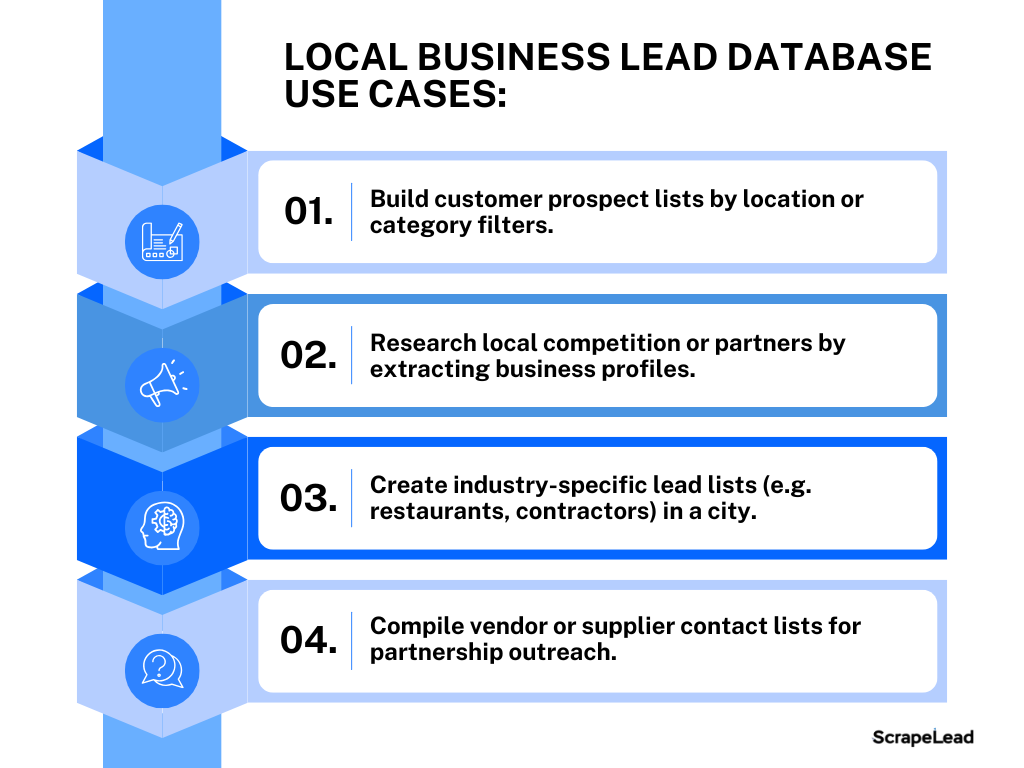
Scaling Potential:

Recommended Tools:
2. Create a Website Contact List Platform
This project aims to scrape websites across a target niche or region, allowing you to build a list of contact pages, emails, and phone numbers. The platform will then automatically compile contact information from the sites, such as support emails or company directories.
The project will serve businesses and agencies needing comprehensive outreach lists or lead information fast.
Use cases:
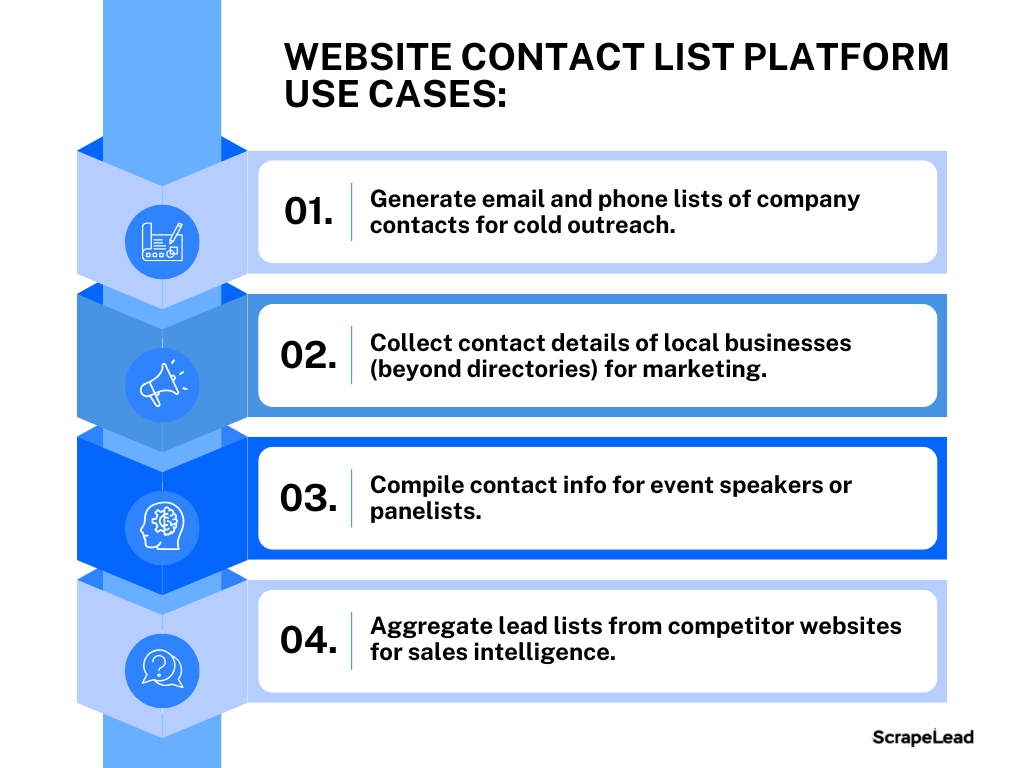
Scaling Potential:

Recommended tools:
3. Build a LinkedIn Networking Database
For this project, you will construct a database of professional profiles from LinkedIn, including job titles and contact details, for networking or recruitment. The database should pull data directly from LinkedIn’s search results.
Use cases:
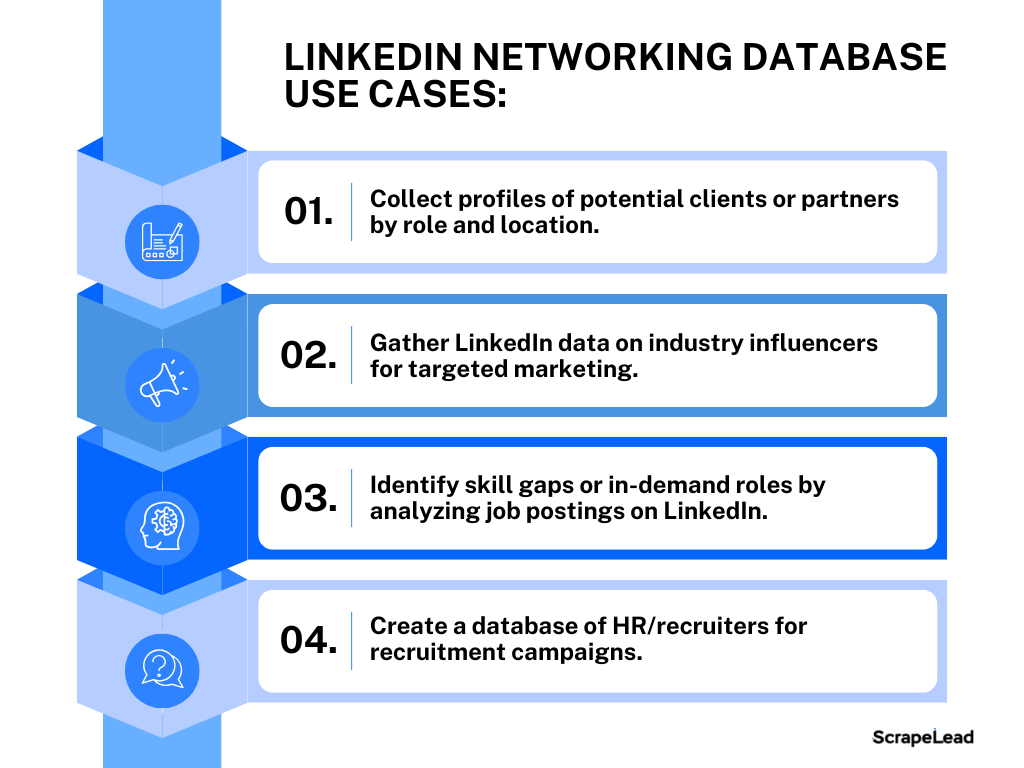
Scaling Potential:

Recommended tools:
4. Develop a Job Market Opportunity Tracker
For this project, you will scrape job listing sites (LinkedIn, Indeed, and Glassdoor) to compile job postings and corporate hiring patterns. The goal is to create a comprehensive database of current opportunities across various industries and professions.
Use cases:
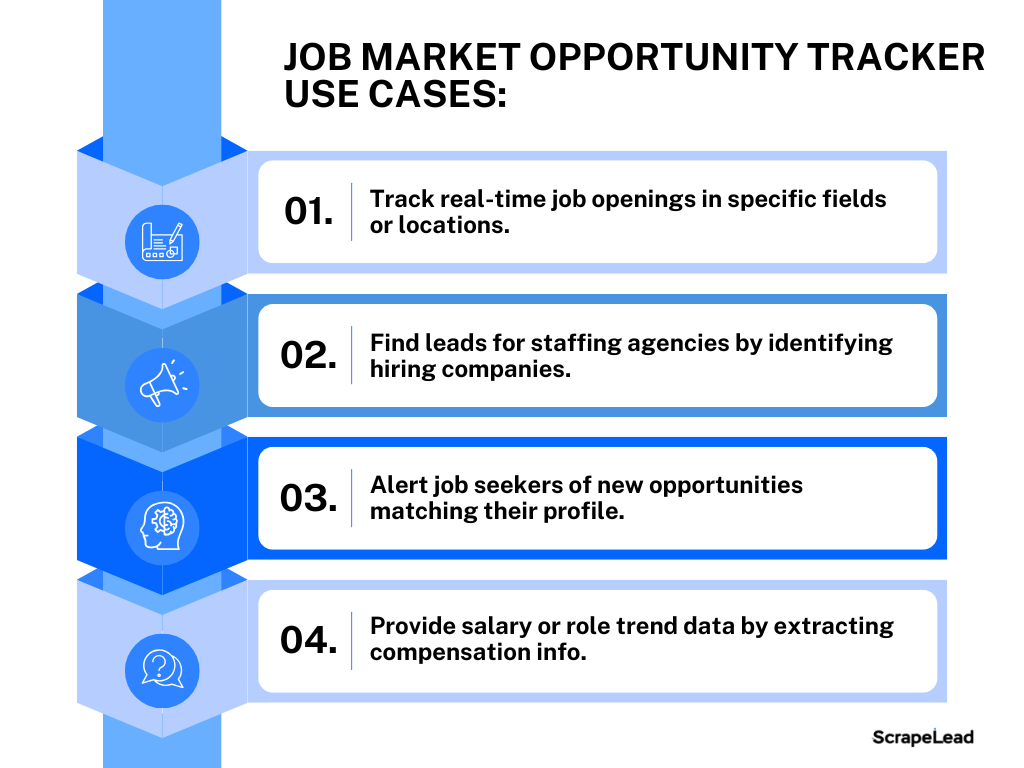
Scaling Potential:

5. Build a Competitor Website Change Tracker
The goal is to develop a website change tracker to monitor competitor website updates. This includes adding new pages, making price adjustments, or offering promotions.
Use cases:
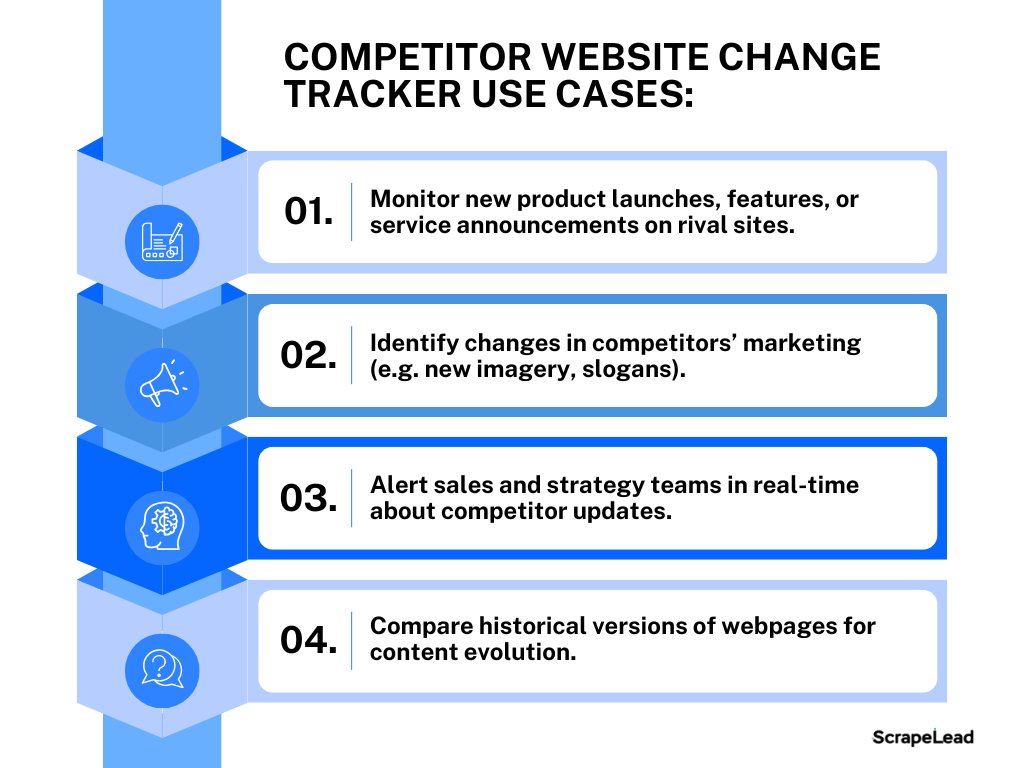
Scaling Potential:
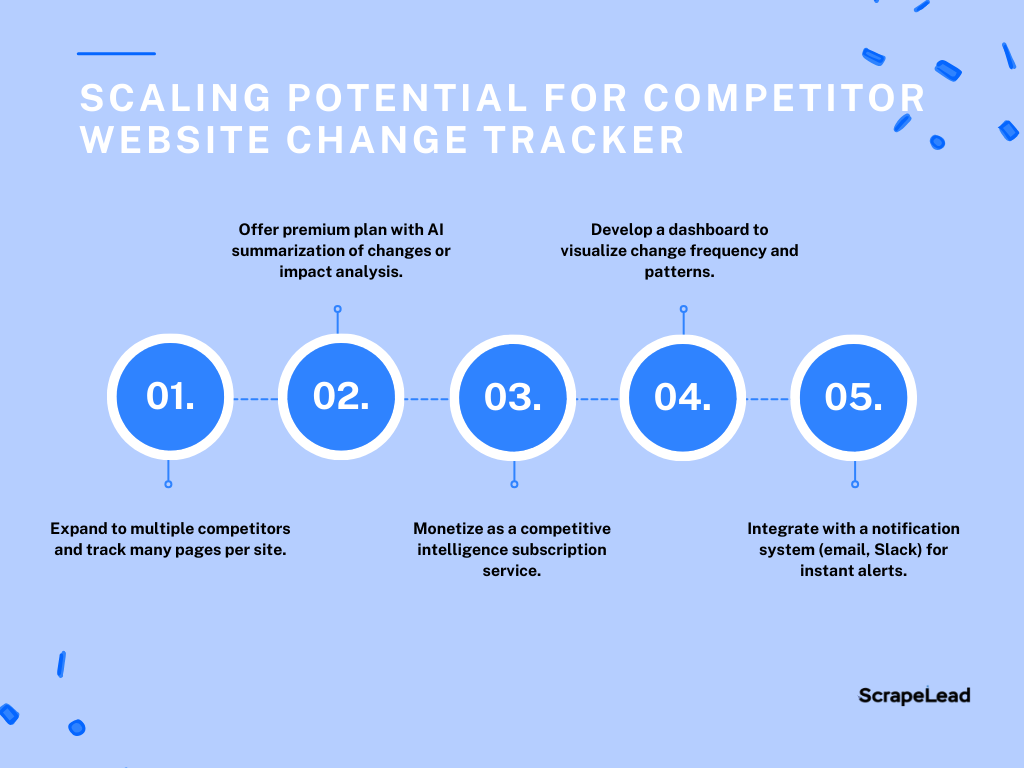
Category 2: E-commerce and Retail
6. Build a Competitor Price Monitoring Tool
The goal of this project is to optimize pricing and identify trends. Your task will involve creating a tool that tracks prices on e-commerce websites, such as Amazon or eBay, where multiple sellers exist.
Use cases:
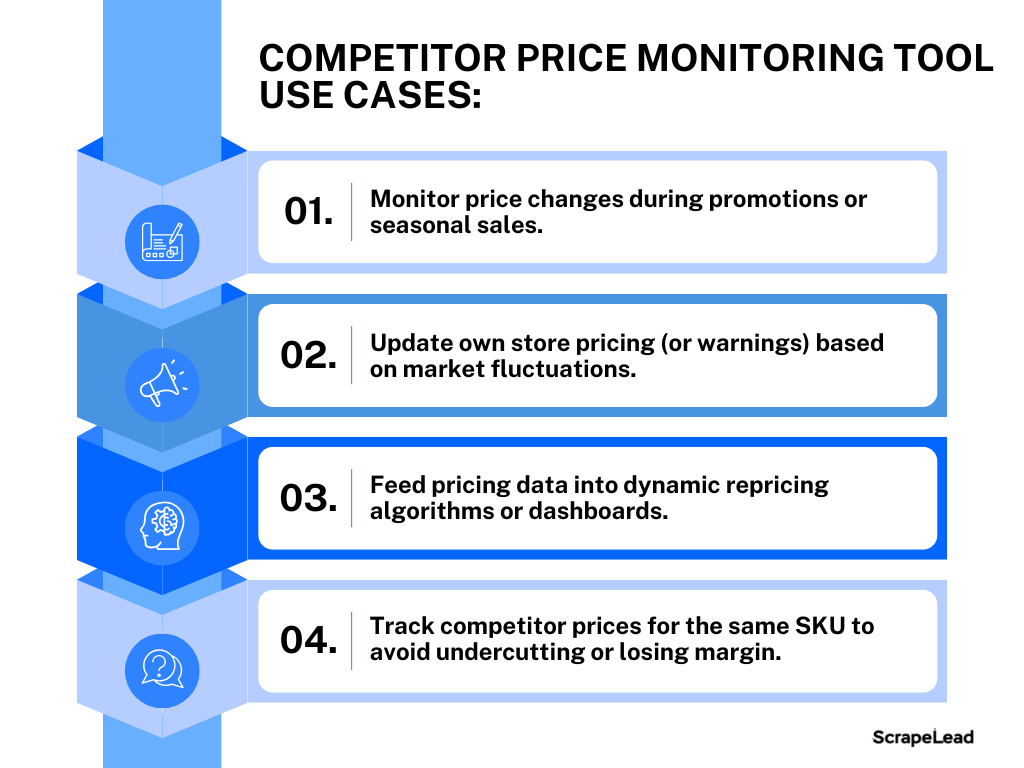
Scaling Potential:

Recommended tools:
7. Create a Customer Review Analysis Platform
Here, you’ll design a platform to analyze consumer reviews from e-commerce or review sites to improve products or services. From complaints to praises, this platform should be able to round up all the information and categorize it.
Use cases:
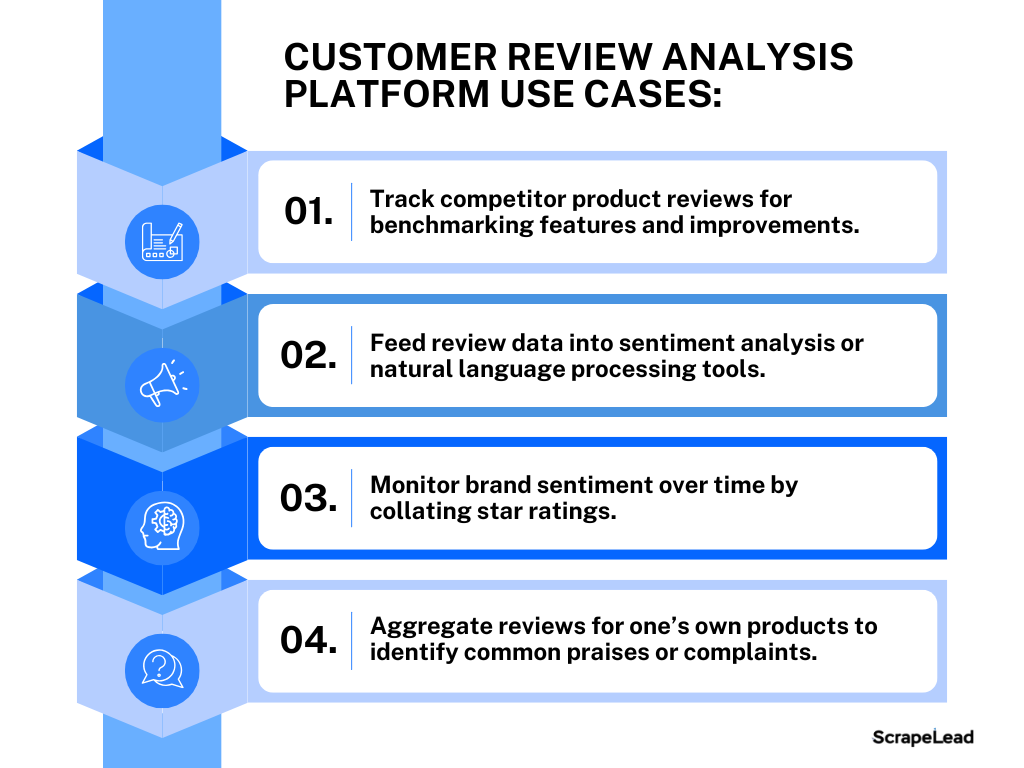
Scaling Potential:

8. Build an Inventory Availability Tracker
Your goal is straightforward: develop an inventory tracker that can scrape e-commerce or retail websites to monitor product availability and inventory levels.
The tracker will easily determine whether items are backordered or in stock across multiple warehouses or merchants.
Use cases:
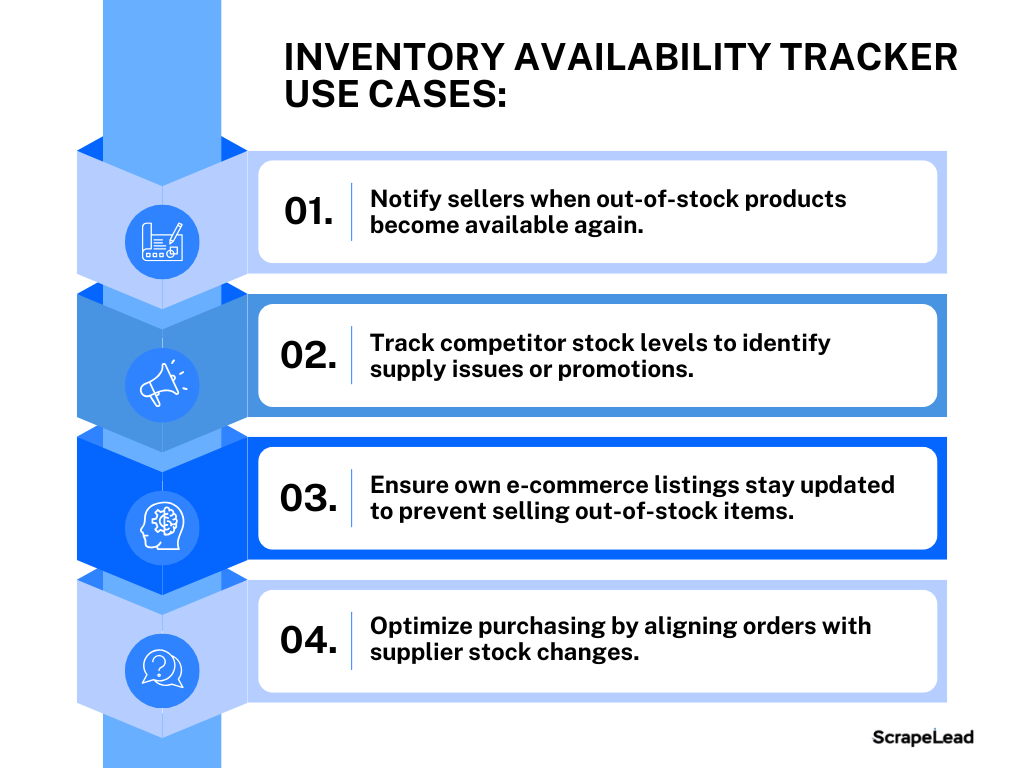
Scaling Potential:

9. Develop a Best-Seller Product Database
For this project, you will create a database of trending or best-selling products from online marketplaces to guide product selection or marketing.
The database will compile top-selling products, categories, and their metadata. It will help businesses identify market trends, find affiliate products, or guide inventory decisions based on current demand.
Use cases:
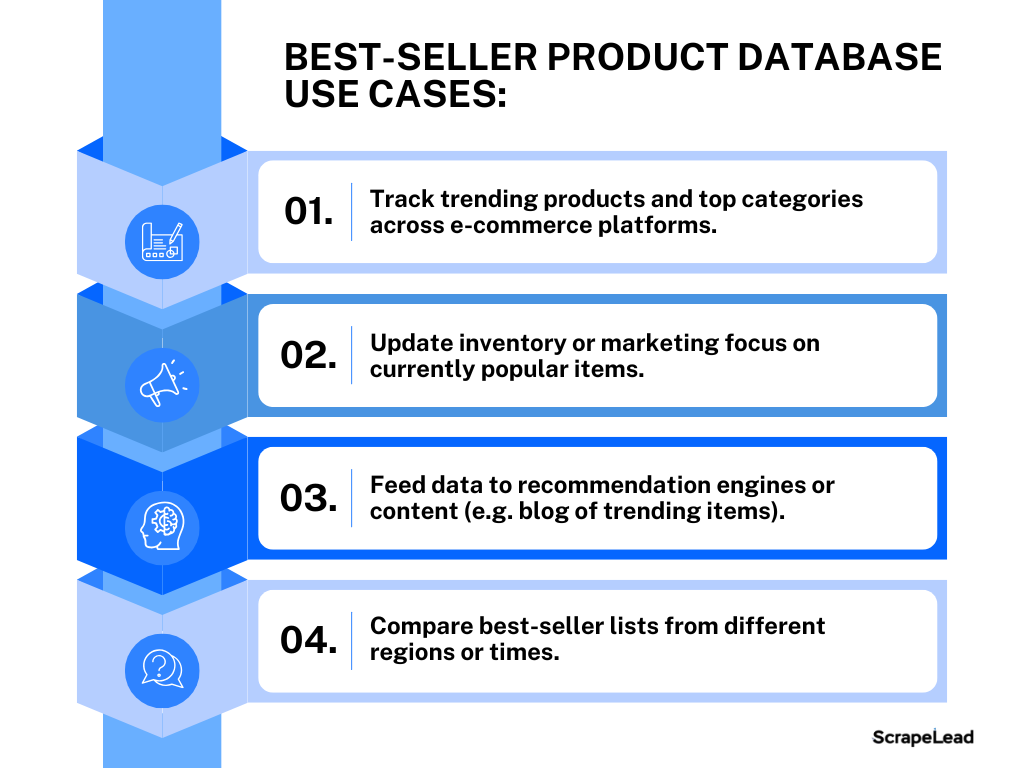
Scaling Potential:

10. Build a Product Comparison Website
Imagine the hassle of going from one website to another. You jump from one, gather or spy on product data, then move to another. What a struggle!
For this project, you will offer a solution for that. You will scrape product information from various e-commerce platforms while gathering features, specifications, and prices.
Use cases:

Scaling Potential:

Category 3: Marketing and Social Media
11. Build a Brand Mention Monitoring Tool
For this project, your goal is to stand out, and this idea does just that! Picture it, how many brands are mentioned all over social media without their knowledge?
Well, your task in this project will be to develop a tool that tracks brand or keyword mentions across blogs, forums, and social media, enabling PR teams to monitor their reputation in real time.
Simply put, the technology will be a warning mechanism for any new online talks about a brand.
Use cases:
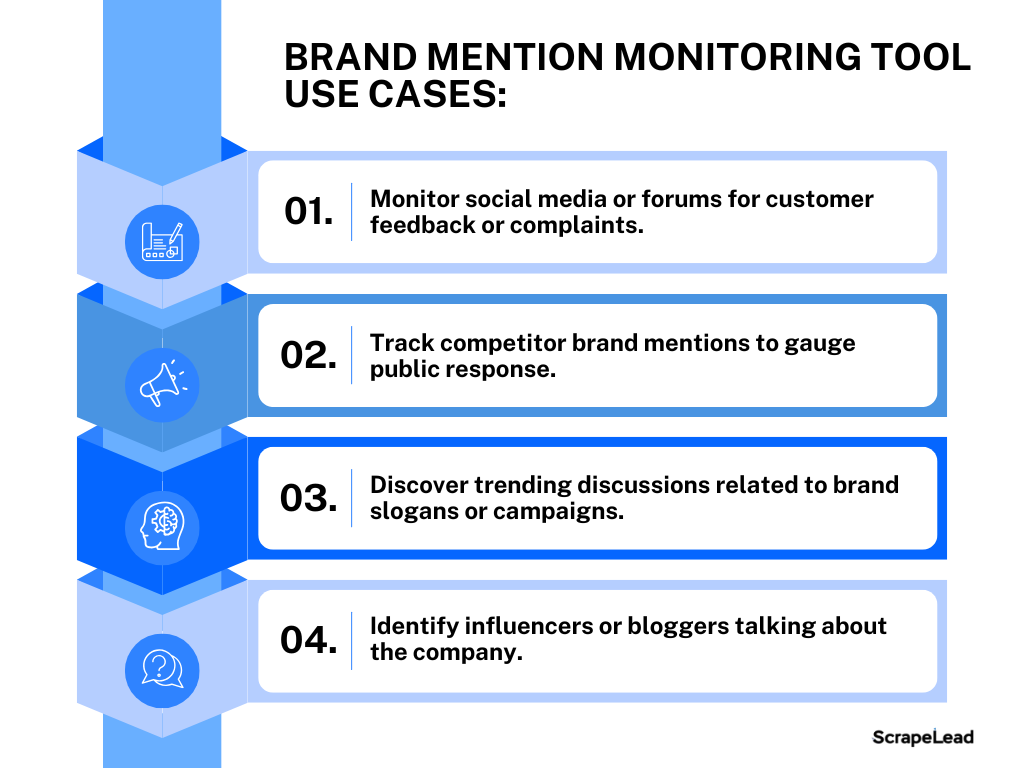
Scaling Potential:

12. Create an Instagram Engagement Analytics Platform
Instagram is highly targeted for engagement, right? So on the app, the main focus often includes:
- Who are you connecting to?
- Who is talking about you?
- What are they thinking?
- What are they saying?
- How do they feel?
All these heavily matter on the platform.
With that in mind, for this project, you will scrape data from Instagram profiles and accounts and organize it according to the engagement platform’s needs.
Moreover, your analytics platform should also be able to track likes, comments, hashtags, and follower growth, which are key engagement metrics on Instagram.
Use cases:
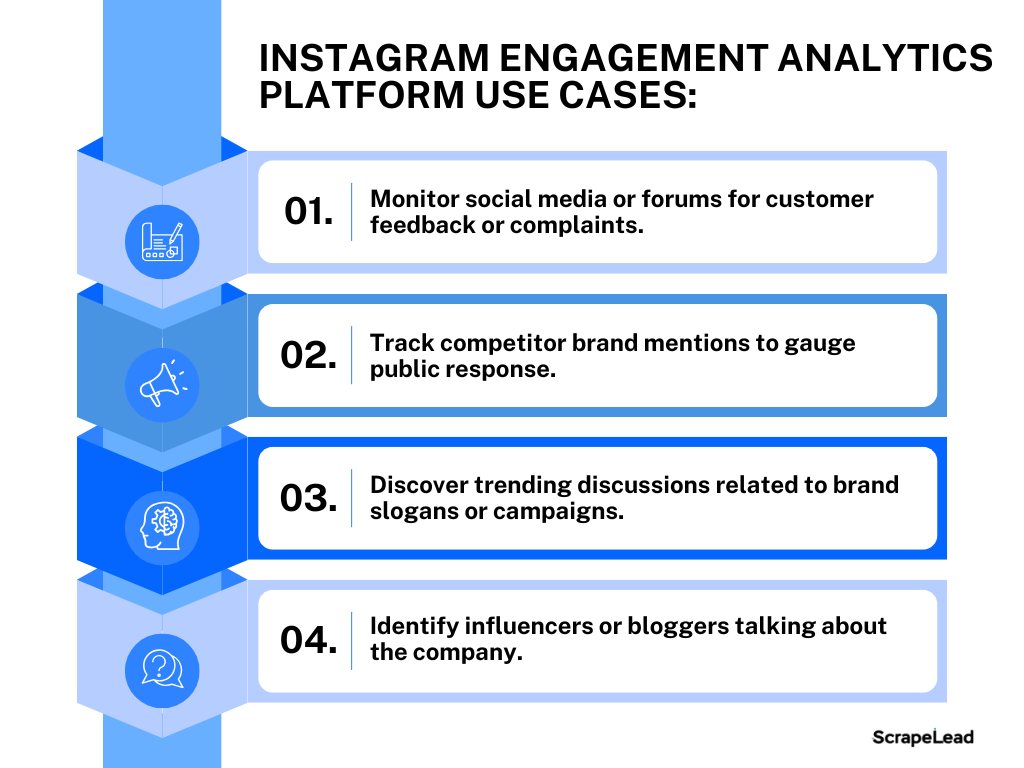
Scaling Potential:

Recommended tool:
13. Build a Reddit Community Insights Database
The goal is to build a database from scraping posts and comments from subreddits. By the end of the project, you will have a fully functional and searchable database of discussions, customer opinions, and trends on your chosen topics or brands.
Marketers and researchers who want to understand customer sentiments and emerging trends will definitely find this a valuable tool and will likely invest in it.
Use cases:
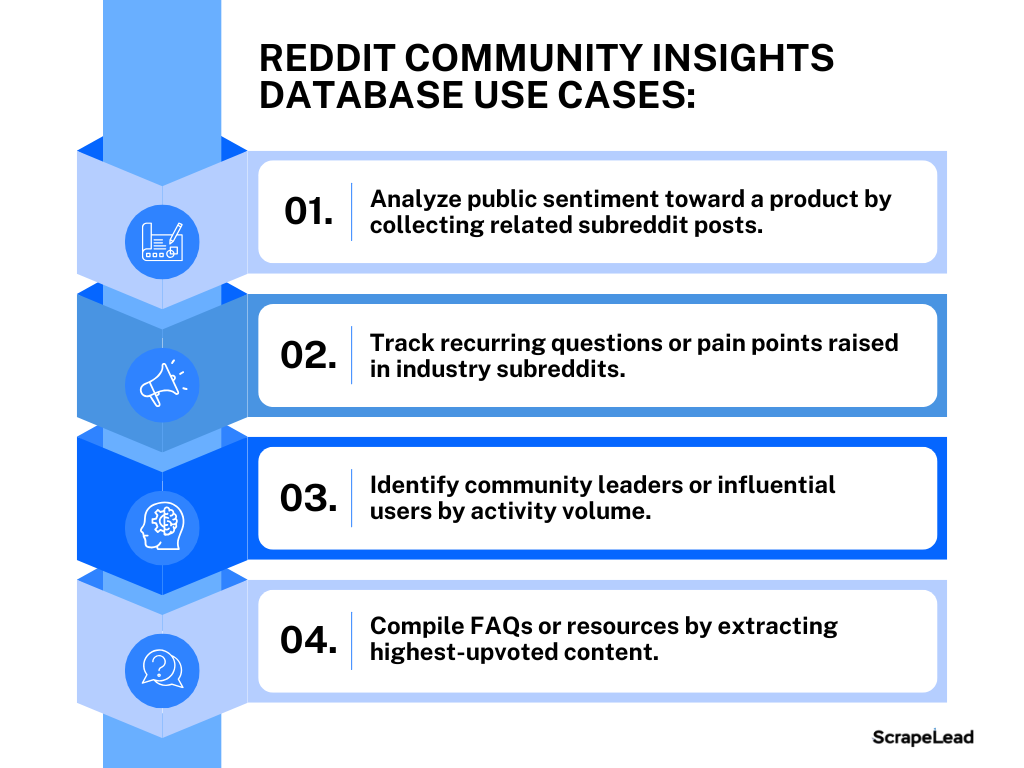
Scaling Potential:

Recommended tool:
14. Develop a YouTube Trend Analysis Tool
For this project, you’ll scrape YouTube for trending videos, view counts, and channel statistics. With this alone, you can easily analyze content popularity.
However, it doesn’t stop there.
The tool should also put together metrics from YouTube’s trending page or specified channels, which can help creators and marketers identify viral topics and audience interests.
Use cases:

Scaling Potential:

Recommended tool:
15. Create a Pinterest Content Idea Scraper
For this project, you’ll scrape Pinterest for popular pins, boards, and trends in specific topics and keywords. This will build up a database of visual content ideas and engagement metrics.
Use cases:
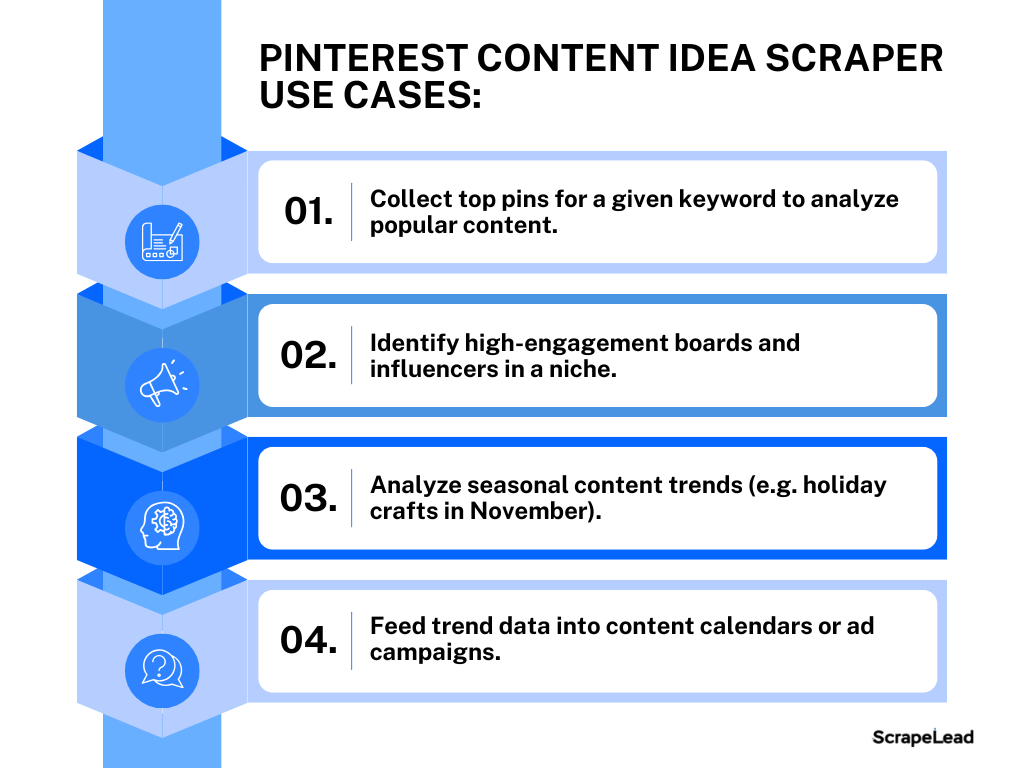
Scaling Potential:

Recommended tool:
Category 4: Real Estate
16. Build an Airbnb Rental Pricing Tracker
For this project, you will scrape Airbnb for listings in target areas to track rates and availability. Over time, you’ll have a tool that collects pricing data for properties by location or type.
The tracker will be a goldmine because hosts and property managers can easily analyze competition and adjust pricing to maximize occupancy and revenue.
Use cases:

Scaling Potential:

Recommended tool:
17. Develop a Real Estate Listing Aggregator
Your primary role for this project will be to gather relevant real estate listings and put them on a single working platform.
Real estate is a crucial market, so the information in the aggregator will be the solution for research and a better understanding of the market.
Use cases:
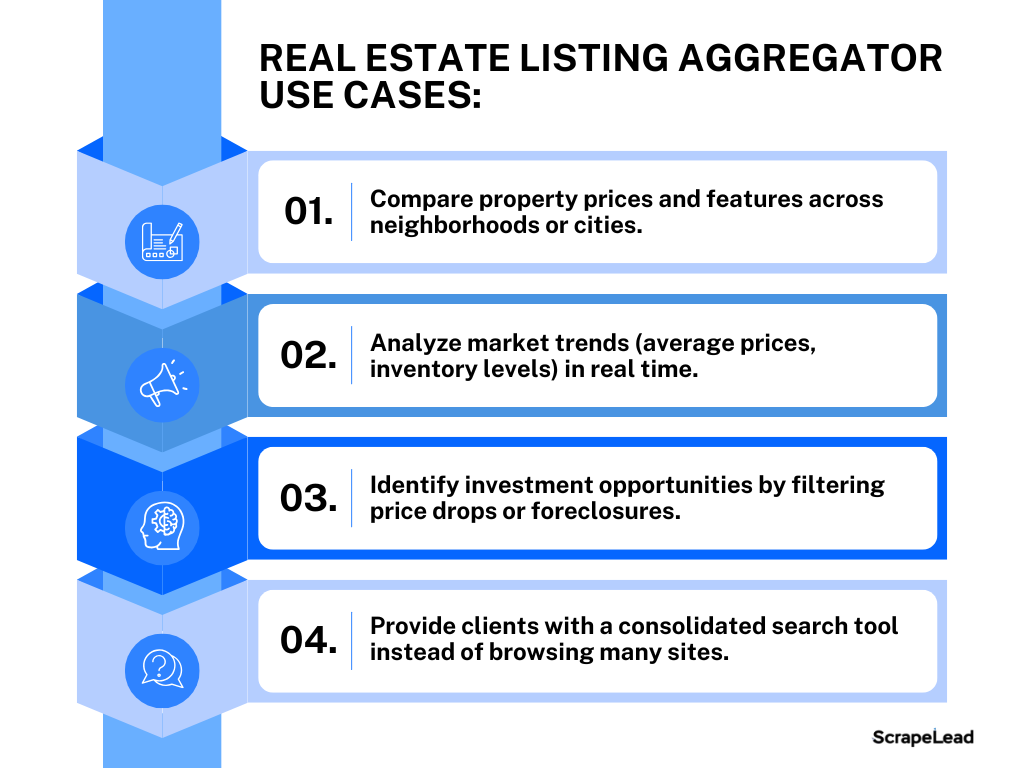
Scaling Potential:

Category 5: News and Events
18. Build an Industry News Aggregation Platform
For this project, you will scrape multiple news websites, blogs, and press releases, and compile a centralized feed of industry-specific news articles.
The platform will also categorize and present the latest updates in various sectors of interest, such as Hospitality, Mining, and Agriculture.
The platform will primarily serve professionals wanting to stay informed without manually searching several sources.
Use cases:

Scaling Potential:

Recommended Tools:
19. Create a Local Event Calendar Database
For this project, you will crawl event websites like Eventbite to collect future events into a single, unified calendar. The database will collect event information, including dates, venues, and descriptions, for specific subjects or areas.
Use cases:

Scaling Potential:

Category 6: Funding and Financial Related
20. Create a Public Tender/Grant Alert System
For this project, you will scrape government and public organization websites for new tender announcements and grant opportunities. You’ll then have a comprehensive alert system that compiles procurement notices and funding calls into one working feed.
The system will help businesses and NGOs identify relevant contracts and grants as soon as they are published.
Use cases:

Scaling Potential:

21. Build a Startup Investment Monitoring Tool
To begin this project, research tech news sites, financing databases, and press releases for recent venture capital investments and startup funding rounds.
Your monitoring tool will then bring together all the relevant information on who invested in particular startups and how much they invested.
Use cases:

Scaling Potential:

22. Develop a Crowdfunding Project Tracker
You will begin this project by tracking new and popular projects by scraping websites like Kickstarter, Indiegogo, and other crowdfunding platforms. Over time, campaign information, including financing targets, commitments, and categories, will be recorded in this database.
Use cases:
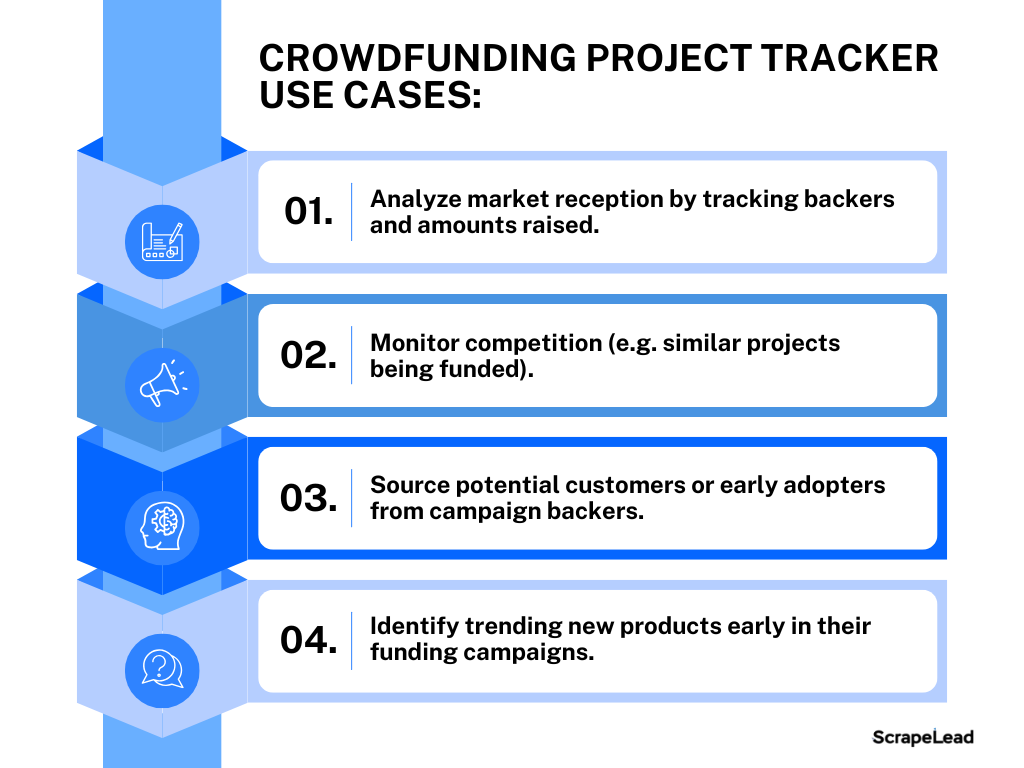
Scaling Potential:

Category 7: Learning and Education
23. Build an Online Course/Skill Gap Analyzer
We saved the finest for last! For this project, you will need to search online learning sites such as Coursera, Udemy, and edX for course offerings.
After storing all the information gathered in one place, the analyzer will compare job market skill requirements sourced from job boards. This will enable it to identify high-demand skills, accessible courses, and training gaps.
Use cases:

Scaling Potential:

Recommended tool:
Bonus: How Do You Validate Your Project Ideas Before You Start?
Before you commit to any project, whether web scraping-related or not, you must validate your ideas. Because here’s the thing, you don’t want or need to waste time or resources on an idea that doesn’t hold up!
Here’s how you can validate your ideas:
1. Perform Quick Scrape Tests
Start by testing your scraping idea with a free web page scraper. Such tools enable you to quickly extract relevant data from a website, allowing you to compare and assess the data’s value.
This may look easy, but a quick scrape test can be the bridge between you pursuing your project and whether to stop it immediately!
2. Perform Competitive Scans
Next, conduct a competitive scan of other scraper sites that may already dominate your proposed project niche or industry.
A quick Google search or a look into industry-specific forums will give you a sense of whether the market is already saturated or there’s room for you to bring in your unique scraping solution.
3. Just Ask!
Put your project out there to real potential users. Ask them if they would find it relevant. Survey them and ask, “Would you pay for faster data?” That’s the one question that can gauge whether there’s actual demand for your project, and whether people are ready to invest in it.
Final Words: Your Next Move
And that’s a wrap. Now, you don’t have just one or two ideas; you have 23 projects on web scraping! Nothing can stop you now. The best part is that they are no-code web scraping projects, eliminating the coding hassle.
The best you can do now is start your search. Even if you don’t use any of the 23 ideas, we hope your mind is fueled with really cool ideas that you can use.
After you decide what you want to work on, be it an easy URL scraper, a data web scraper, or a data scraping program, just select your ideal tool, connect it to a data source, and begin building.
- No more blank screens.
- No more analysis paralysis.
- Just data-driven action.
We made a promise, and we delivered! So, whether you want to go for any of these projects, or you got some inspiration, we believe the process has just become somewhat simplified.
Ready to start working?
Related Blog

11 Real-World Use Cases of Web Scraping in 2025
Explore 11 powerful examples of web scraping and see how to use data to gain insights, leads, and a market edge in 2025.

Which Review Scraper Is Best for Your E-commerce Business?
Want a simple way to start scraping reviews? Learn how to grab real customer feedback and make smarter product decisions fast.

How to Scrape Social Media Without Coding (2025 Guide)
Discover how to collect social media data effortlessly with no-code tools in this 2025 guide.
